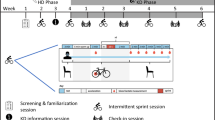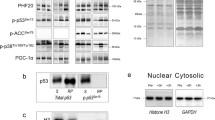Summary
To determine the effect of one-legged sprint training on muscle pH and nonbicarbonate buffering capacity (BC), 9 subjects completed 15 to 20 intervals at 90 RPM, 4 days a week for 7 weeks on a bicycle ergometer adapted for one-legged pedaling. Needle biopsies from the vastus lateralis and blood samples from an antecubital vein were taken at rest and twice during recovery (1 and 4 minutes) from a 60 s one-legged maximal power test on a cycle ergometer. pH one minute after exercise in both the trained and untrained legs following the training period was not different but both were higher than before training. BC increased from 49.9 to 57.8 μmol HCl×g−1×pH−1 after training (p<0.05). Blood lactate levels after exercise were significantly higher for the trained leg when compared to the untrained leg after sprint training. Peak and average power output on the 60 s power test increased significantly after training. One-legged aerobic power (\(\dot V_{{\text{O}}_{{\text{2}} {\text{max}}} } \)) significantly increased in the untrained and trained legs. Two-legged\(\dot V_{{\text{O}}_{{\text{2}} {\text{max}}} } \) also improved significantly after training. These data suggest that nonbicarbonate buffering capacity and power output can be enhanced with one-legged sprint training. Also, small but significant improvements in\(\dot V_{{\text{O}}_{{\text{2}} {\text{max}}} } \) were also observed.
Similar content being viewed by others
References
Abe H, Dobson G, Hoeger U, Parkhouse W (1985) Role of histidine-related compounds to intracellular buffering in fish skeletal muscle. Am J Physiol 249:R449-R454
Albers C, Vaupel P (1981) Non-bicarbonate buffering of ascites tumor cells in the rat as titrated by strong acids. Resp Physiol 45:287–297
Bergstrom J (1962) Muscle electrolytes in man. Scand J Clin Lab Invest (Suppl 68) 14:1–110
Castellini MA, Somero GN (1981) Buffering capacity of vertebrate muscle: Correlations with potential for anaerobic function. J Comp Physiol 143:191–198
Cheetham M, Williams C, Lakomy H (1985) A laboratory running test: metabolic responses of sprint and endurance trained athletes. Br J Sports Med 19:81–84
Costill D, Sharp R, Rink W, Katz A (1982) Determination of human muscle pH in needle-biopsy specimens. J Appl Physiol 53:1310–1313
Costill D, Barnett A, Sharp F, Fink W, Katz A (1983) Leg muscle pH following sprint running. Med Sci Sports Exerc 15:325–329
Evans JA, Phinney SD, Young V (1982) Suction applied to a muscle biopsy maximizes sample size. Med Sci Sports Exerc 14:101–102
Fox EL, Mathews DK (1981) The physiological basis of physical education and athletics (3rd ed). Saunders, Toronto
Hermansen L, Osnes JB (1972) Blood and muscle pH after maximal exercise in man. J Appl Physiol 32:304–308
Medbo J, Sejersted O (1985) Acid-base and electrolyte balance after exhausting exercise in endurance-trained and sprinttrained subjects. Acta Physiol Scand 125:97–109
Neary PJ, Wenger HA (1985) The effects of continuous versus discontinuous cycling on the lactate and ventilation thresholds. J Human Mov Stud 11:151–157
Parkhouse WS, McKenzie PW, Hochachka PW, Ovalle WK (1985) Buffering capacity of deproteinized human vastus lateralis muscle. J Appl Physiol 58:14–17
Penman K (1969) Ultrastructural changes in human striated muscle using three methods of training. Res Q 10:722–746
Roos A, Boron WF (1981) Intracellular pH. Resp Physiol 61:296–434
Sahlin K, Alvestrand A, Brandt R, Hultman E (1978) Intracellular pH and bicarbonate concentration in human muscle during recovery from exercise. J Appl Physiol 45:474–480
Sahlin K, Henriksson J (1984) Buffer capacity and lactate accumulation in skeletal muscle of trained and untrained men. Acta Physiol Scand 122:331–339
Sahlin K, Edstrom L, Sjoholm H, Hultman E (1981) Effects of lactic acid accumulation and ATP decrease on muscle tension and relaxation. Am J Physiol 240:C121-C126
Saltin B, Nazar K, Costill DL, Stein E, Jansson E, Essen B, Gollnick PD (1976) The nature of the training response; peripheral and central adaptations to one-legged exercise. Acta Physiol Scand 96:289–305
Sharp RL, Costill DL, Fink WJ, King DS (1986) Effects of eight weeks of bicycle ergometer sprint training on human muscle buffer capacity. Int J Sports Med 7:13–17
Sigma Chemical Company (1981) The quantitative determination of pyruvic acid and lactic acid. Sigma Technical Bulletin No. 826-UV. Sigma Chemical Company, St Louis
Stamford BA, Moffat RJ, Weltman A, Maldonado C, Curtis M (1978) Blood lactate disappearance following supramaximal one-legged exercise. J Appl Physiol 45:244–248
Troup JP, Metzger JM, Fitts RH (1986) Effect of high intensity exercise training on functional capacity of limb skeletal muscle. J Appl Physiol 60:1743–1751
Author information
Authors and Affiliations
Rights and permissions
About this article
Cite this article
Bell, G.J., Wenger, H.A. The effect of one-legged sprint training on intramuscular pH and nonbicarbonate buffering capacity. Europ. J. Appl. Physiol. 58, 158–164 (1988). https://doi.org/10.1007/BF00636620
Accepted:
Issue Date:
DOI: https://doi.org/10.1007/BF00636620




